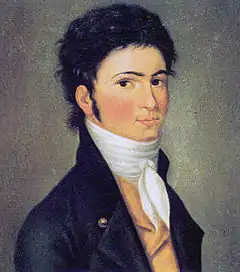Piano Sonata No. 12 (Beethoven)
Ludwig van Beethoven composed his Piano Sonata No. 12 in A♭ major, Op. 26, in 1800–1801, around the same time as he completed his First Symphony. He dedicated the sonata to Prince Karl von Lichnowsky, who had been his patron since 1792.

Consisting of four movements, the sonata takes around 20–22 minutes to perform.
Structure
- Andante con variazioni 3
8 A♭ major - Scherzo, allegro molto 3
4 A♭ major, D♭ major, A♭ major - Maestoso andante, marcia funebre sulla morte d'un eroe 4
4 A♭ minor, A♭ major - Allegro, Rondo form 2
4 A♭ major
The structure of the sonata is unconventional in that the piece opens with a relatively slow movement in the format of theme and variations. The third movement incorporates a funeral march, clearly anticipating the watershed of the Eroica Symphony that Beethoven wrote in 1803–1804. This is the only movement from his sonatas that Beethoven arranged for orchestra, and was played during Beethoven's own funeral procession in 1827.[1]
This sonata is also unusual in that none of its four movements is in sonata-allegro form.
In most of Beethoven's four-movement sonatas, the third movement is in 3
4 and in ternary form, while the second movement is slow and in a different key from the other movements. In this sonata, the second and third movements have switched roles, where the second movement is the ternary scherzo and trio, while the third movement is the slow movement in the tonic minor.
First movement
The movement consists of a theme by Beethoven and five variations. The third variation has been called a "pre-echo" of the funeral march movement by Andras Schiff during his lecture on the sonata. [2] This movement is also unusual in the sense that it is not in sonata form but rather a set of variations on a theme.
Second movement
Third movement
In some editions there are no tempo markings, just "Marcia Funebre, sulla morte d'un Eroe" ("Funeral March, relating to the death of a hero")
Beethoven transcribed this movement for orchestra as part of a suite of incidental music to Johann Duncker's play Leonore Prohaska, bearing the catalog number WoO 96.
Fourth movement
Influences
The main theme of Schubert's Impromptu in A♭ major, Op. 142 No. 2 is strikingly similar to the theme in the first movement of Beethoven's sonata. The four-bar phrases that open these pieces are almost identical in most musical aspects: key, harmony, voicing, register, and basic as well as harmonic rhythm. Another less immediate connection exists with the main theme, also in A♭ major, of the Adagio movement in Schubert's piano sonata in C minor, D. 958. Indeed, Schubert may have borrowed these themes from Beethoven, as he often did in his compositions.
This sonata was greatly admired by Chopin, who repeated its basic sequence of scherzo, funeral march with trio, and perpetuum mobile finale in his own Piano Sonata in B♭ minor.[3] His first movement, however, is also animated and in sonata form, unlike Beethoven's Andante con variazioni.
References
- Kinderman, William (2009). Beethoven (2nd ed.). New York: Oxford University Press. p. 100. ISBN 978-0-19-532825-7.
- "András Schiff Beethoven Lecture-Recitals". wigmore-hall.org.uk. Retrieved 10 April 2017.
- Petty, Wayne C. (Spring 1999). "Chopin and the Ghost of Beethoven". 19th-Century Music. 22 (3): 281–299. JSTOR 746802.
Further reading
- Rosen, Charles, Beethoven's Piano Sonatas – A Short Companion, 2002, Yale University Press, pp. 150–152.
- Adolph Bernhard Marx,"Introduction to the Interpretation of Beethoven Piano Works", pp. 110–113. IMSLP Books.
External links
- A lecture by András Schiff on Beethoven's piano sonata Op. 26
- For a public domain recording of this sonata visit Musopen
- Piano Sonata No. 12: Scores at the International Music Score Library Project
- Recording by Paavali Jumppanen, piano from the Isabella Stewart Gardner Museum
| Wikimedia Commons has media related to Piano Sonata No. 12 (Beethoven). |



